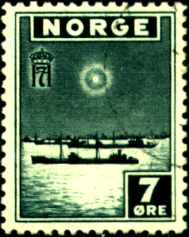
|
Maritime Topics On Stamps :
The Battle of the Atlantic in WW II.
|
|
During the 1930s Great Britain possessed the world’s largest merchant fleet
with 6,700 oceangoing vessels. Yet, Britain’s dependence on the goods
transported by these ships would pose grave dangers in times of war. Such was
the case in World War I and even more so during World War II. To provide
Great Britain and the continent with food stuff and war materials from the
United States, the allies employed the convoy system. A gigantic battle was
fought on the high seas
the ‘Battle of the Atlantic’
during the years 1940 to 1945.
|
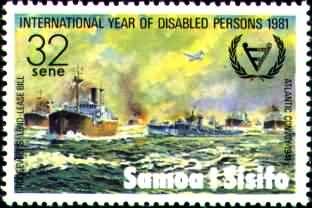
| |
‘Wolf packs’ of German U-boats attacked these
convoys desperately defended by destroyers, frigates, corvettes, and airplanes.
Approximately 80,000 merchant mariners and navy sailors from both sides
perished in the stormy and icy seas of the North Atlantic.
|
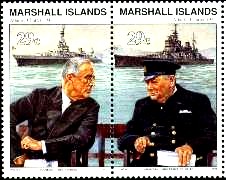
|
In March 1941 the U.S.Congress passed the ‘Lend-Lease-Act’. This law
authorized President Franklin D. Roosevelt to assist any nation whose defense was
deemed of vital interest to the United States. It became the basis of
American help to Great Britain. President Franklin D. Roosevelt and Prime
Minister Winston Churchill met in July of 1941 in Argentia Bay, off Newfoundland,
and signed a declaration, the ‘Atlantic Charter’,
defining the mutual political goals of both nations, namely to end ‘Nazi Tyranny’
and to bring peace to the world. The stamp commemorates this historical event.
|
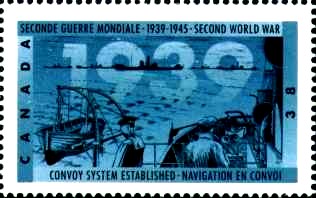 In WW II, a typical ocean convoy consisted of 12 to 40 merchant ships,
protected by destroyers, frigates, corvettes, and airplanes. There were some
200 different ocean tracks; 94 of them came under U-boat attack. These routes
were named mostly with letters, some also with numerals. The first letter
represented the port or country of departure, the second letter the destination.
A third letter showed the assigned speed, ‘F’ for ‘fast’ and ‘S’ for ‘slow’.
As seen from Britain, ‘H’ meant ‘home’ and ‘O’ stood for ‘outward’.
Examples are ‘HX’ (=Home from Halifax), ‘ONF’ (=Outward for North America Fast)
and ‘MKS’ (=Mediterranean to UK Slow).
In WW II, a typical ocean convoy consisted of 12 to 40 merchant ships,
protected by destroyers, frigates, corvettes, and airplanes. There were some
200 different ocean tracks; 94 of them came under U-boat attack. These routes
were named mostly with letters, some also with numerals. The first letter
represented the port or country of departure, the second letter the destination.
A third letter showed the assigned speed, ‘F’ for ‘fast’ and ‘S’ for ‘slow’.
As seen from Britain, ‘H’ meant ‘home’ and ‘O’ stood for ‘outward’.
Examples are ‘HX’ (=Home from Halifax), ‘ONF’ (=Outward for North America Fast)
and ‘MKS’ (=Mediterranean to UK Slow).
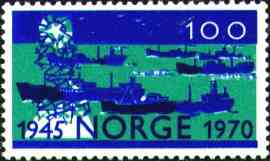 The most vital routes were those from the U.S. and Canada to Great Britain
and to Murmansk. Most of the fighting occurred here. Often a dozen convoys with
more than 20,000 crew crossed the Atlantic at the same time with speeds
between seven and nine knots. In perilous waters they sailed in zig-zag patterns
to be less vulnerable to attack. In 1940 Great Britain required imports of
43 million tons, and 38 million tons thereafter. These materials had to be moved
by convoys. From 1940 to 1942 this was not possible, consequently foods had to
be rationed in Britain. The Canadian stamp symbolizes merchant ships
forming a convoy. The stamp on the left shows a convoy underway with a
symbol representing the Norwegian resistance.
The most vital routes were those from the U.S. and Canada to Great Britain
and to Murmansk. Most of the fighting occurred here. Often a dozen convoys with
more than 20,000 crew crossed the Atlantic at the same time with speeds
between seven and nine knots. In perilous waters they sailed in zig-zag patterns
to be less vulnerable to attack. In 1940 Great Britain required imports of
43 million tons, and 38 million tons thereafter. These materials had to be moved
by convoys. From 1940 to 1942 this was not possible, consequently foods had to
be rationed in Britain. The Canadian stamp symbolizes merchant ships
forming a convoy. The stamp on the left shows a convoy underway with a
symbol representing the Norwegian resistance.
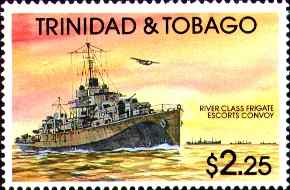 The convoys were defended by destroyers, frigates, corvettes, sloops and cutters,
with additional assistance of airplanes and shore based support. One of
anti-submarine warfare’s most important tools was the device called ASDIC by
the British and SONAR by the Americans, which detected submerged submarines
by means of sound wave transmissions. Its range was about 1,400 meters
(1,500 yards). Escort vessels surrounding convoys with their Asdic gear provided
a protective shield which U-boats had to penetrate first before
being able to fire. Once detected, submarines were pursued by the faster surface
vessels and carpeted with depth charges. Later Sonar improvements even detected
launched torpedoes and determined a submerged U-boat’s depth. Then came the advent
of RADAR which would spot periscopes and High Frequency Direction Finders
(HF/DF) which would pinpoint a U-boat’s position even during very brief radio
transmissions. While escorts dropped TNT-filled canister depth charges airplanes
employed cannons and dropped acustical torpedoes.
The convoys were defended by destroyers, frigates, corvettes, sloops and cutters,
with additional assistance of airplanes and shore based support. One of
anti-submarine warfare’s most important tools was the device called ASDIC by
the British and SONAR by the Americans, which detected submerged submarines
by means of sound wave transmissions. Its range was about 1,400 meters
(1,500 yards). Escort vessels surrounding convoys with their Asdic gear provided
a protective shield which U-boats had to penetrate first before
being able to fire. Once detected, submarines were pursued by the faster surface
vessels and carpeted with depth charges. Later Sonar improvements even detected
launched torpedoes and determined a submerged U-boat’s depth. Then came the advent
of RADAR which would spot periscopes and High Frequency Direction Finders
(HF/DF) which would pinpoint a U-boat’s position even during very brief radio
transmissions. While escorts dropped TNT-filled canister depth charges airplanes
employed cannons and dropped acustical torpedoes.
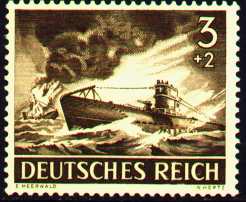 This stamp shows a German U-boat of type VII-a during a nighttime surface
attack. These boats made 8 knots while submerged and 17 knots on the surface.
Length was 66 meters; there were four torpedo tubes in the bows and one in
the stern. Armed with 14 torpedoes, their diving range was to a depth of 100
meters. With crews of approx. 50 men, operating range was 6,500 nautical
miles at an average speed of 12 knots. Proving the low esteem submarines were
held in by the naval command, at the outbreak of war Germany disposed of just
56 U-boats, only 27 of which were operational at the time. Yet, their number
had risen to 1,177 by war’s end in 1945. A U-boat veteran of WW I, Admiral
Karl Dönitz was the commander-in chief of all submarine forces.
This stamp shows a German U-boat of type VII-a during a nighttime surface
attack. These boats made 8 knots while submerged and 17 knots on the surface.
Length was 66 meters; there were four torpedo tubes in the bows and one in
the stern. Armed with 14 torpedoes, their diving range was to a depth of 100
meters. With crews of approx. 50 men, operating range was 6,500 nautical
miles at an average speed of 12 knots. Proving the low esteem submarines were
held in by the naval command, at the outbreak of war Germany disposed of just
56 U-boats, only 27 of which were operational at the time. Yet, their number
had risen to 1,177 by war’s end in 1945. A U-boat veteran of WW I, Admiral
Karl Dönitz was the commander-in chief of all submarine forces.
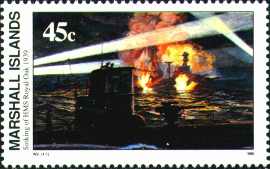 U-boat warfare commenced with an embarrassing miscalculation on the first day
of the war: U-30 mistook the British passenger liner ‘Athenia’ for an armed
troop transport and sank her without warning . 118 passengers perished, 22
Americans among them.Concerned about the American response, Germany tried a
cover-up. Shortly thereafter, though, the daring exploits of U-47 mesmerized
the nation: Commander Günther Prien penetrated the naval base at Scapa Flow
and sank the British battle ship ‘Royal Oak’. This is shown on the stamp at
left. Rapidly, Germany built up construction of U-boats, commissioning ten
boats per month by early 1941.
U-boat warfare commenced with an embarrassing miscalculation on the first day
of the war: U-30 mistook the British passenger liner ‘Athenia’ for an armed
troop transport and sank her without warning . 118 passengers perished, 22
Americans among them.Concerned about the American response, Germany tried a
cover-up. Shortly thereafter, though, the daring exploits of U-47 mesmerized
the nation: Commander Günther Prien penetrated the naval base at Scapa Flow
and sank the British battle ship ‘Royal Oak’. This is shown on the stamp at
left. Rapidly, Germany built up construction of U-boats, commissioning ten
boats per month by early 1941.
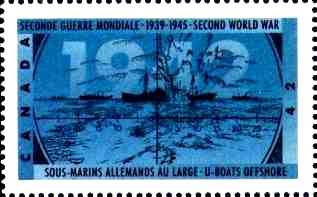 1940 was the year often called the ‘fortunate epoch’ for German submariners.
122 merchantmen were sunk between March and May; from mid-June to October
another 300 Allied vessels with 1.5 million gross tons were sent to the
bottom. Individual U-boats, operating alone, were responsible for these
successes. Starting in 1941, Adm. Dönitz organized his North Atlantic fleet
into three groups stationed strategically along major ocean routes. Whenever
a convoy was sighted, the boat did not attack on its own but instead followed
from a safe distance and advised Berlin headquarters. From there, all boats
in the vicinity were dispatched to the scene, surrounded the convoy, and then
launched simultaneous surface attacks at nighttime. Some U-boats would
surface right amongst their prey. The escort vessels had difficult times
dealing with the enemy: In pursuit of one boat they left a gap for others to
penetrate and fire their torpedoes. Zig-zag maneuvering of the freighters
added to the confusion. These were the typical ‘wolf pack’ tactics of the
‘gray wolves’, as the U-boats were soon nicknamed.
1940 was the year often called the ‘fortunate epoch’ for German submariners.
122 merchantmen were sunk between March and May; from mid-June to October
another 300 Allied vessels with 1.5 million gross tons were sent to the
bottom. Individual U-boats, operating alone, were responsible for these
successes. Starting in 1941, Adm. Dönitz organized his North Atlantic fleet
into three groups stationed strategically along major ocean routes. Whenever
a convoy was sighted, the boat did not attack on its own but instead followed
from a safe distance and advised Berlin headquarters. From there, all boats
in the vicinity were dispatched to the scene, surrounded the convoy, and then
launched simultaneous surface attacks at nighttime. Some U-boats would
surface right amongst their prey. The escort vessels had difficult times
dealing with the enemy: In pursuit of one boat they left a gap for others to
penetrate and fire their torpedoes. Zig-zag maneuvering of the freighters
added to the confusion. These were the typical ‘wolf pack’ tactics of the
‘gray wolves’, as the U-boats were soon nicknamed.

During the early years of the war, a large number of convoy battles were
fought within the so-called air gap, an area in the North Atlantic beyond the
reach of air power. Convoys needed four days steaming to pass through this
danger zone.Two major sea battles tell the story: In November of 1942 convoy
SC-107 lost 15 vessels with 82,430 tons to a wolf pack of ten U-boats. March
of 1943 saw the last great convoy battle when 38 submarines converged on
convoys SC-122 and HX-229. Within four days 22 Allied ships were sunk and
one fourth of all the sailors aboard the escort vessels lost their lives,
while the Germans lost just one U-boat in this action. But soon thereafter
the tide turned against Nazi Germany.
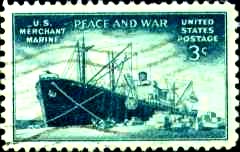 The ‘Battle of the Atlantic’ was a series of many deadly engagements covering
some four million square miles of ocean and lasting five long years. Victory
meant supreme control over North Atlantic shipping. The German U-boat force
tried to sink Allied shipping at a rate faster than replacements could be
constructed. Worldwide, during 1941 and 1942, the German Navy sank 2,963
Allied bottoms while just 863 new American-built vessels entered service.
Commencing in 1941, the U.S. undertook a gigantic newbuilding program to
produce tremendous numbers of relatively inexpensive ships in record times.
18 new shipyards with altogether 171 slips were created. Based upon the
British ‘Ocean class’ design, a simple yet efficient type of freighter came
into being, originally called ‘Emergency Ships’.
The ‘Battle of the Atlantic’ was a series of many deadly engagements covering
some four million square miles of ocean and lasting five long years. Victory
meant supreme control over North Atlantic shipping. The German U-boat force
tried to sink Allied shipping at a rate faster than replacements could be
constructed. Worldwide, during 1941 and 1942, the German Navy sank 2,963
Allied bottoms while just 863 new American-built vessels entered service.
Commencing in 1941, the U.S. undertook a gigantic newbuilding program to
produce tremendous numbers of relatively inexpensive ships in record times.
18 new shipyards with altogether 171 slips were created. Based upon the
British ‘Ocean class’ design, a simple yet efficient type of freighter came
into being, originally called ‘Emergency Ships’.
 Their drab gray appearance earned them the nickname ‘ugly ducklings’. Then,
President Roosevelt proclaimed their purpose as providing Europe with liberty
hence their new designation as ‘Liberty Ships’. The very first Liberty ship
was SS ‘Patrick Henry’ depicted on the stamp with the sea gull. She was
delivered in December of 1941. Building her took 150 days, yet very soon the
Americans revolutionized their methods of construction. Most successful were
the Kaiser Shipyards of California. For the SS ’Robert E. Peary’, 250,000
components were pre-fabricated at locations across the country. Then, it took
just four days, 15 hours, and 29 minutes to join those sections for a
completed Liberty ship! This became an absolute record. By 1944, average
construction times including individual components took just 42 days.
Their drab gray appearance earned them the nickname ‘ugly ducklings’. Then,
President Roosevelt proclaimed their purpose as providing Europe with liberty
hence their new designation as ‘Liberty Ships’. The very first Liberty ship
was SS ‘Patrick Henry’ depicted on the stamp with the sea gull. She was
delivered in December of 1941. Building her took 150 days, yet very soon the
Americans revolutionized their methods of construction. Most successful were
the Kaiser Shipyards of California. For the SS ’Robert E. Peary’, 250,000
components were pre-fabricated at locations across the country. Then, it took
just four days, 15 hours, and 29 minutes to join those sections for a
completed Liberty ship! This became an absolute record. By 1944, average
construction times including individual components took just 42 days.
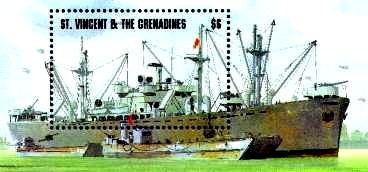 Liberty ships were 441’ long, 57’ wide, of 7,176 gross tons and 10,500 tons
deadweight, with five hatches and a speed of 11 knots. Between 1941 and 1945,
a total number of 2,751 Liberty ships were completed; their type prefix was
‘EC2’. A slightly larger design called ‘Victory Ship’ was built from 1943
onwards, capable of 15 to 17 knot speeds. The first specimen was the SS
‘United Victory’, commissioned in February of 1944. Altogether 541 Victory
ships went into service, as type ‘VC2’. Their length was 445’, breadth 62’,
with a gross tonnage of 7,607. Just like the Liberty ships, they were armed
with bow and stern guns and anti-aircraft cannons, manned by naval personnel.
In addition, 550 rapidly constructed T2 and T3 tankers were placed into
service.
By August of 1942 Allied ship construction fully compensated for their
losses. During 1943 American and Canadian shipyards produced 140 freighters
per month.
Liberty ships were 441’ long, 57’ wide, of 7,176 gross tons and 10,500 tons
deadweight, with five hatches and a speed of 11 knots. Between 1941 and 1945,
a total number of 2,751 Liberty ships were completed; their type prefix was
‘EC2’. A slightly larger design called ‘Victory Ship’ was built from 1943
onwards, capable of 15 to 17 knot speeds. The first specimen was the SS
‘United Victory’, commissioned in February of 1944. Altogether 541 Victory
ships went into service, as type ‘VC2’. Their length was 445’, breadth 62’,
with a gross tonnage of 7,607. Just like the Liberty ships, they were armed
with bow and stern guns and anti-aircraft cannons, manned by naval personnel.
In addition, 550 rapidly constructed T2 and T3 tankers were placed into
service.
By August of 1942 Allied ship construction fully compensated for their
losses. During 1943 American and Canadian shipyards produced 140 freighters
per month.
|
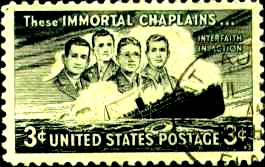
|
February of 1943 saw the American troopship SS ‘Dorchester’ enroute to
Greenland. The soldiers aboard were to be stationed at U.S. bases on the
island. Suddenly, there was a torpedo hit amidships, followed by an explosion
in the engine room. Panic-stricken troops rushed to the decks. Amongst the
confusion the ship’s officers were assisted by four Army chaplains who
encouraged the men, prayed with them, distributed life vests and helped them
into the lifeboats. When it became apparent that there was a shortage of life
preservers, the four chaplains took off their own and handed them to others.
They perished with their ship -- true heroism in a cruel war!
|
|
The change of fortune in the battle of the Atlantic began already in March of
1941. While attacking a convoy south of Greenland’s coast, massive depth
charges forced U-110 to the surface. A commando unit of the British destroyer
‘Bulldog’ managed to board the boat and to capture the all-important Enigma
code apparatus. It only took a few months and the British secret service was
listening in to all German naval radio messages. When the Germans changed
their chiffres in February of 1942, by the end of the year the British had
deciphered these codes as well. Every transmitted convoy sighting and U-boat
position and intended targets were thus known to the Allies. They knew when,
where, and how many subs were planning an attack and were able to take
appropriate countermeasures.
|
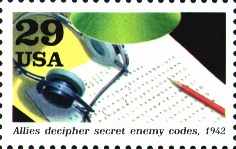
|

|
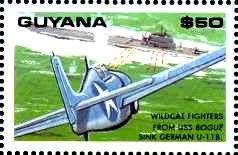
|
Yet another Enigma code was employed in March of 1943 and the Germans were
able to sink 22 vessels of convoys SC-122 and HX-229. Once more, the British
were able to crack the codes. That same month also saw the Allied deployment
of escort carriers which finally closed the air gap, surrounding the convoys
with steady air support. An attack on convoy ONS-5 in May of 1943 sank twelve
merchant ships but also resulted in the loss of seven U-boats. Two weeks
later an 18-boat wolf pack was about to assault convoy SC-130. The Allies
were fully forewarned and acted accordingly, also altering the convoy’s
course. Just ten subs were able to make visual contact; only one of them got
close enough to attack, but without success. Six U-boats were sunk, not one
merchant ship was lost. The submerged submarines were detected by ASDIC and
carpeted with depth charges exploding at various depths. From the air, Allied
planes dropped sonar buoys detecting the submarines’ positions and acoustical
torpedoes homing in onto the sound of their propellers. Surfaced U-boats were
pinpointed with radar, attacked with airborne guns and rammed by escort
vessels. Then the Allies formed ‘Hunter Killer Groups’ consisting of an
escort carrier and planes, destroyers, and frigates. A famous ‘Escort Group’
was lead by Captain F. Johnny Walker. Once a submarine was detected, it was
doomed. This group managed to sink 20 U-boats. Another crucial factor in
anti-submarine warfare at this time was the deployment of ‘very long range
aircraft’.
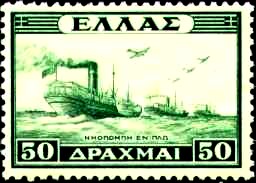 The boats had no more hopes to succeed. Between January and April 1943
fifty-seven U-boats were lost. Another 41 sank in May. Faced with these
casualties Admiral Dönitz abandoned his previous North Atlantic combat
tactics. Altogether 237 boats were lost in 1943, then 238 in 1944, and an
additional 123 in 1945. More and more convoys managed to cross the Atlantic
without casualties. In the fall of 1944, 159 vessels sailed the route to
Murmansk and none of them was sunk.
The Germans had lost the ‘Battle of the Atlantic’. Altogether, German U-boats
sank 2,759 merchant ships and 148 men-of-war during World War II. Some
sources report 2,828 merchant vessels lost. Germany had built 1,162 boats of
which 784 became wartime casualties. Of the approximately 40,000 U-boat
sailors 28,000 lost their lives and some 5,000 became prisoners-of-war. No
other branch of military service had ever suffered such a high seventy
percent rate of casualties.
The boats had no more hopes to succeed. Between January and April 1943
fifty-seven U-boats were lost. Another 41 sank in May. Faced with these
casualties Admiral Dönitz abandoned his previous North Atlantic combat
tactics. Altogether 237 boats were lost in 1943, then 238 in 1944, and an
additional 123 in 1945. More and more convoys managed to cross the Atlantic
without casualties. In the fall of 1944, 159 vessels sailed the route to
Murmansk and none of them was sunk.
The Germans had lost the ‘Battle of the Atlantic’. Altogether, German U-boats
sank 2,759 merchant ships and 148 men-of-war during World War II. Some
sources report 2,828 merchant vessels lost. Germany had built 1,162 boats of
which 784 became wartime casualties. Of the approximately 40,000 U-boat
sailors 28,000 lost their lives and some 5,000 became prisoners-of-war. No
other branch of military service had ever suffered such a high seventy
percent rate of casualties.
Notice: Different sources say different data!

Slogan cancel, December 1943: More than 32 million gross tons are gone!
|
|